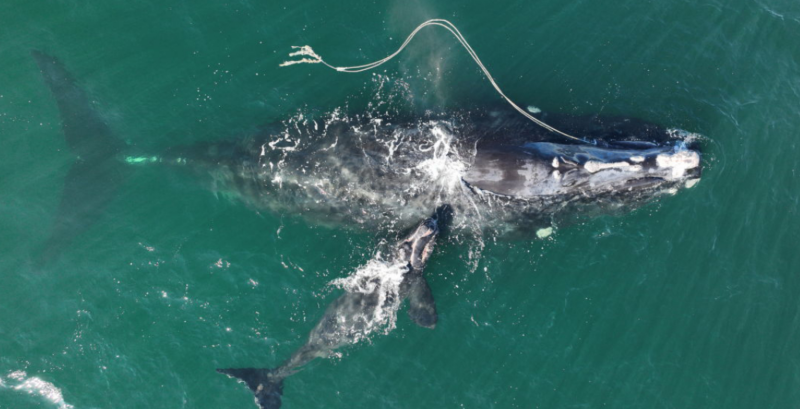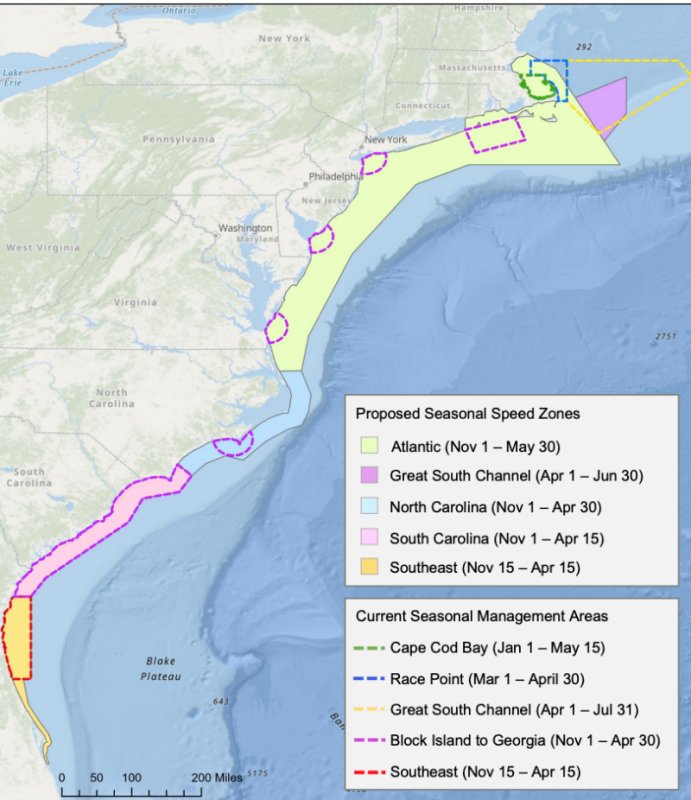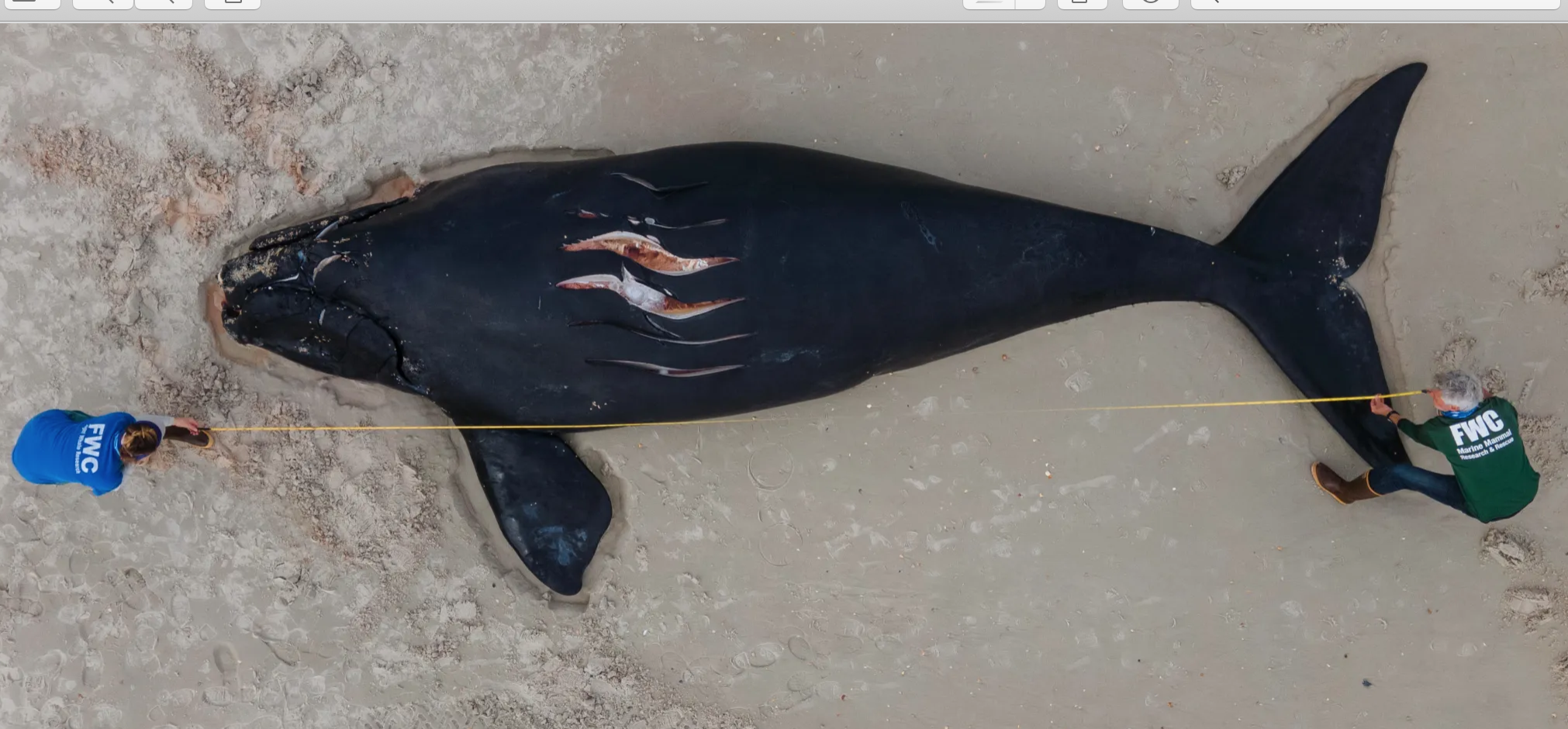Recreational fishing businesses are protesting a plan to impose speed restrictions on smaller vessels to protect endangered North Atlantic right whales off the U.S. East Coast.
“This would be a devastating regulatory mandate,” said Pat Healey, the president and CEO of Viking Yachts in New Gretna, N.J., in a statement issued Sept. 21 by the builder of high-end sportfishing boats. “Right whale vessel strikes have just not been an issue for our industry. This is a classic example of government overreach.”
The right whale population is estimated at around 340 animals at danger of extinction, with fewer than 100 breeding females. Vessel strikes and entanglement in fishing gear are the biggest hazards to whales as they swim between Canada and Florida, according to the National Oceanic and Atmospheric Administration.
Northeast lobster fishermen are under increasing pressure for new gear and area restrictions to reduce the danger of whale entanglements. To reduce ship strikes, NOAA regularly issues alerts warning of right whale sightings in East Coast shipping lanes, calling for reduced ship speeds.
Now NOAA has proposed requiring vessels between 35 feet and 65 feet to maintain 10-knot speeds when transiting designated “seasonal management areas” where right whales are known to migrate.
The speed limit alerts, put out by NOAA’s National Marine Fisheries Service, are based on intense aerial monitoring of the whales' movements. The agencies’ own analyses have found the 10-knot limit is not always observed by bluewater container ship operators coming into East Coast ports. Speed restrictions are a major consideration for offshore wind energy companies planning to develop lease areas in right whale waters – and the shipbuilders who will build their future U.S. fleet.
But accidents when smaller vessels struck right whales have focused attention on the recreational and charter fishing fleet. NOAA extended a public comment period on the proposed rule until Oct. 31 after protests from recreational fishing interests.
“The proposed rule, as written, would be the most consequential maritime regulation that we have ever seen imposed on the recreational boating and fishing sector,” said John DePersenaire, Viking’s director of government affairs and sustainability, in a Sept. 21 statement from the company. “It will affect not only boat owners but marinas, tackle shops, charter boat operators – basically all maritime-related businesses on the Atlantic Coast.”
“We had heard talk of a proposal but were never directly contacted in any way,” said DePersenaire. He says the rule “would force thousands of recreational boats to operate at a speed that compromises their maneuverability and overall safety at sea.”
“Now that we have the extension, we really need to turn up the volume and make sure our voices are heard,” said Healey. “Everyone needs to rally – yacht clubs, marinas, fishing clubs, charter boat associations. This is a huge deal that not many people know about.”
Political pressure over the right whale speed restrictions even showed up in Congress, when the House Committee on Natural Resources debated changes to the Magnuson-Stevens Fishery Conservation and Management Act on Sept. 21. Republican committee members had proposed an amendment to force NOAA into reconsidering the speed restrictions, but their proposal was rejected.
The rule would extend seasonal restrictions to “a huge swath” of ocean “outside of the extreme Northeast,” said committee member Rep. Garret Graves, R-La.
Graves and other critics contend that pressure to adhere to 10-knot limits could lead captains to put their vessels at risk in deteriorating weather and sea conditions. NOAA says its proposal includes “updates to the rule’s safety provisions, allowing vessels to exceed the 10-knot restriction in limited circumstances.”
“Vessels less than 65 feet in length account for five of the 12 documented lethal strike events in U.S. waters since the first speed rule went into effect in 2008, demonstrating the significant risk this vessel size class presents and the need to extend the speed restrictions to include smaller vessels,” according to NOAA documents on the rule proposal.
Recreational advocates are citing those numbers, much in the way that the Maine Lobstermen’s Association stresses that there has not been a documented case of whale entanglement with lobster gear since 2004.
But with the right whale population estimated at just around 340 animals – and fewer than 100 breeding females – there is intense pressure to prevent any losses to the species, which is strictly protected under the federal Endangered Species Act and Marine Mammals Protection Act.
“For decades, vessel strikes and entanglements in fishing gear have been the two primary causes of right whale injury and death,” according to NOAA’s announcement of intent to implement the vessel speed restrictions.
“Researchers found that between 2003 and 2018, in cases where a cause of death could be determined, all juvenile and adult right whale deaths were attributable to human activities. Beyond the first year of life, right whales are not living long enough to die of natural causes.”
There’s already a long-running federal court battle over restrictions on lobster fishermen. The under-65 feet speed restriction proposal could open up a whole new legal front.
Extending the speed restrictions got some impetus after a 2021 incident when a young right whale calf died after it was struck by a 54-foot sportfishing yacht inbound to a Florida inlet.
In recent days New England Aquarium whale researchers reported sighting an adult female right whale close to death off New England, severely injured by fishing gear entanglement. Dubbed Snow Cone by scientists tracking the right whale population, the whale’s first calve was killed by a boat collision off New Jersey. Her second has not been seen since April, according to the aquarium’s Cabot Center for Ocean Life.

Along with fishing gear restrictions, NMFS is already under pressure to do more on enforcing speed restrictions for vessels over 65 feet. In January 2021 an analysis by the agency found speed restrictions are often ignored, according to automatic identification system (AIS) ship tracking.
NOAA documents in support of the speed proposal say “the majority of vessel strike mortality risk occurs during cooler months (November – May) when North Atlantic right whale densities are predicted to be high in waters of the mid-Atlantic, southern New England, and the southeastern U.S. Expanding 15 speed zones to encompass these areas is expected to reduce the overall risk of vessel strike mortality by an average of 27.5 percent.”








